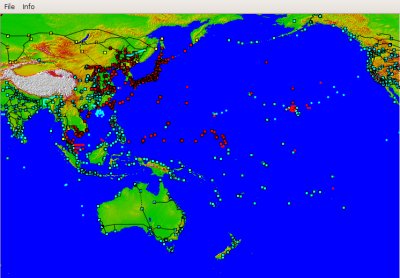![]() The Pacific War Online Encyclopedia
The Pacific War Online Encyclopedia
|
| Table of Contents |

War games refer to two activities, one professional, the other a hobbyist pursuit.
Military simulations. The
Prussian Army first began training
its officers using a war game (German: Kriegspiel) as early as 1811. The
notion caught on with other armed forces, including the Japanese, who extensively wargamed
proposed operations, such as the Centrifugal Offensive
(including the Pearl Harbor
strike) and the Midway operation.
Such war games were deadly serious, and the more sober designation military simulations became the
preferred term after wargaming as a hobby became popular in the postwar
era. Military simulations of the Pacific War era were typically
conducted with boards, markers, and dice, according to a set of rules,
with the two opposing sides in separate rooms with umpires giving only
that information on what the other team was doing that they could have
been aware of through their own side's intelligence.
Such military simulations could be effective at getting military
leaders to think about possible outcomes and hazards of an operation.
Their ability to predict likely outcomes was more problematic,
requiring that the rules be tuned to reflect actual experience. This
could be done for past engagements but required a dangerous level of
extrapolation to future conflicts with new tactics and technology.
Japanese wargaming of the Centrifugal Offensive actually overestimated
the likely casualties, but the war games conducted prior to the Midway
operation correctly predicted that there was potential for a
devastating American ambush. This disquieting result was
simply ignored.
Wargaming was also subject to "mirror imaging", in which wargamers
tended to project their own capabilities onto the enemy. Since every
navy assumed the best of its own capabilities and doctrine, projecting those capabilities and doctrine on the enemy was simply being conservative. American wargamers assumed that the Yamatos were similar to the Iowas, that the Japanese could not have oxygen-powered torpedoes when both the British and Americans had failed to make them work, and that Japanese ships had similar resistance to damage as American ships. In fact, the Yamatos and Iowas were quite dissimilar, the Japanese had deployed the oxygen-powered Long Lance torpedo, and Japanese ships were generally less resistant to damage and had inferior damage control compared with American ships.
Wargaming was adopted by the U.S. Naval War College just prior to the First World War and championed postwar by Admiral William S. Sims. American military simulations performed at the Army and Naval War Colleges traditionally denoted American forces as Blue, with other colors used to designate other powers. For example, England was Red, Germany was Black, and Japan was Orange. These designations were adopted for contingency plans in the event of war, so that Plan Orange was the contingency plan for a war with Japan, while Rainbow was a set of contingency plans for war with various combinations of allies and enemies. The Navy War College published extensive Maneuver Rules and Combat Effects Tables which, by 1941, amounted to several hundred pages. The rules were strictly followed, with umpires intervening only to rule on situations overlooked by the rules. Logistics were an important part of the maneuver rules and all ranks were encouraged to critique the results. Simplified rules were used for fleet exercises, and the results were taken very seriously; admirals were known to be passed over for promotion if they blundered in fleet exercises.
In Japanese
war games, the umpire had much greater latitude to overrule the formal
rules than in American war games. The war games also had a tendency to
brush aside logistical
constraints,
sometimes simply assuming that fleet at sea would somehow be refueled.
The war games were often highly political, one of their purposes being
to build consensus by acquainting officers with operational plans and
drawing out any opposition to the plans. This was particularly evident
during the war games staged by Yamamoto to explore plans for the Pearl Harbor operation.
By the end of the war, the Allies
had developed operational research, of which military simulation was an
important component, into a sophisticated mathematical science. For
example, the ASWORG (Antisubmarine Warfare Operational Research Group)
was organized by the U.S. Navy in March 1942, and it and its British
counterparts greatly improved Allied antisubmarine tactics.
Wargaming as a hobby. Warfare has always fascinated even when it has also appalled. Wargaming as a hobby became popular during the 1970s and 1980s, when the medium was almost always boards and cardboard counters, with outcomes usually determined by dice rolls. The advent of home computers transformed hobby wargaming into a largely computer-based activity.
This Encyclopedia was originally inspired by the authors' interest in wargaming and much of the information in it has been organized with hobby wargame designers as a target audience.
Orders of battle:
References
StrategyPage.com (accessed 2010-5-3)
The Pacific War Online Encyclopedia © 2010, 2012, 2014 by Kent G. Budge. Index